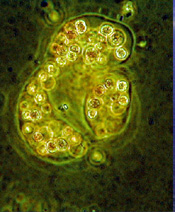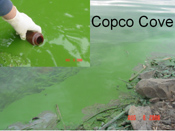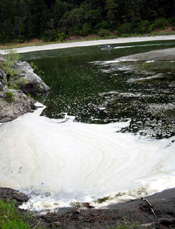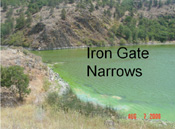Toxic Algae
- The toxic blue-green algae Microcystis aeruginosa has been identified in KHP reservoirs and downstream all the way to the Klamath River estuary.
- Microcystin toxins present a substantial threat to both human and fish health.
- PacifiCorp's Iron Gate and Copco reservoirs serve as incubators that are directly responsible for the increasing levels of Microcystis and microcystin toxin detected in the lower Klamath River.
- Dam removal is the only sure remedy for reducing Microcystis and stopping the poisoning of the Klamath River.
- PacifiCorp's Final License Application failed to mention problems with Microcystis even though the company often detected it in lower KHP reservoir surveys.
- In its FEIS, FERC acknowledges the problem with Microcystis but recommends leaving Iron Gate and Copco Reservoirs in place and only directs monitoring to alert the public of toxic algae blooms.
Note: this page has not been updated for several years. More recent info is available on the Documents and the Klamath Basin Monitoring Program (KBMP) Blue Green Algae Tracker page.
Blue-green algae - "cyanobacteria" -, are a diverse group of single-celled aquatic organisms found in surface waters worldwide. Lakes, reservoirs, ponds, and slow-moving rivers are especially suitable for blue-green algae, which can create nuisance conditions when there is calm water, light, and adequate concentrations and ratios of nitrogen and phosphorus. The resulting high cyanobacterial algal concentrations are not only unpleasant to see (or smell), but can produce toxins that sicken pets, livestock and even humans. Human effects range from skin inflammation and stomach upset to death from liver or respiratory failure.
In September, 2004 water samples taken near the margin of Copco Reservoir showed extremely high concentrations of Microcystis aeruginosa, a potentially toxic species of blue-green algae (Kann, 2004).
The samples taken from Copco Reservoir, which is in California, yielded cell counts of 1,900,000 cells/ml. The State of Oregon closes water bodies to surface contact at 15,000 cells/ml and closes them to all human activity at 100,000 cells/ml. Laboratory tests also found Microcystin toxin was being produced at levels of 482 ug/L, which is 482 times higher than the 1 ug/L maximum for microcystin recommended for drinking water by the World Health Organization (Chorus and Bartram, 1999). The Quartz Valley Indian Community (2005) notified FERC of the problems with toxic algae in KHP reservoirs in January 2005.
Table of World Health Organization levels of human health risk for Microcystis aeruginosa cell counts and toxins from Chorus and Bartram (1999).
WHO Level of Health Risk |
Cell Counts (cells/ml) |
Toxin Levels (ug/L) |
Low Risk |
20,000 |
4 |
Moderate Risk |
100,000 |
20 |
Severe Risk |
10,000,000 or scums |
200 |
Sampling by the Karuk Tribe in Iron Gate and Copco Reservoirs during 2005 detected Microcystis in more than 85% of their July-October samples and microcystin toxins at levels that pose a severe risk to public health at some sites (Kann, 2005; Kann and Corum, 2006). The maximum Microcystis aeruginosa density detected was 11,402,943 cells/ml in Copco Reservoir with an attendant microcystin toxin concentration of 667 mg/liter. Open water locations varied from 151,004 to 916,548 cells/ml. Cell counts and toxins are highest near shorelines where wind concentrates algae blooms into scums and potential for human or livestock contact is greatest. No Microcystis was found in the Klamath River above Copco Reservoir. The Karuk Tribe’s 2006 monitoring data showed similar trends as the 2005 data (Kann and Corum, 2007).
The California Environmental Protection Agency (2005) offered the following:
The Microcystis aeruginosa cyanobacteria levels and resulting microcystin toxin concentrations detected in water samples collected from both shoreline and open water locations in the Copco and Iron Gate Reservoirs in California pose a significant potential threat of adverse health affects in human and animals exposed through direct ingestion of contaminated water as well as incidental ingestion during recreational water activities and bathing.
The Yurok Tribe Environmental Program (YTEP, 2006) and U.S. Fish and Wildlife Service environmental scientists found Microcystis at all Klamath River sites measured in late August and September 2005, as far downstream as the estuary. Although Microcystis cell counts and toxin measurements were much lower in the Klamath River than in KHP reservoirs, "cell concentration exceeded 1.3 million cells/ml in a backwater area near the confluence of Coon Creek nearly 100 miles downstream from Iron Gate Dam" (YTEP, 2006). Most fish tissue samples collected by the Yurok Tribe yielded no microcystin toxins, but two liver samples from steelhead did show detectable levels (YTEP, 2006). Kann (2006) suggests that fish health risk posed by blue-green algae toxins may be greater for steelhead because of slower travel rates than salmon, and the fact that they continue to feed while in freshwater.
The presence of microcystin toxins in the Klamath River below Iron Gate Dam also pose potential health risk to Native Americans and to sport anglers because the timing of blooms coincides with periods when ceremonial use and fishing are most active (YTEP, 2006) .
The Yurok Tribe’s 2006 and 2007 monitoring data showed similar trends as the 2005 data (YTEP, 2007; YTEP 2008).
Kann (2006) concluded that Iron Gate and Copco Reservoirs provide ideal habitat for Microcystis, which then inoculates the Klamath River below the KHP. PacifiCorp (2005) argued that Upper Klamath Lake was also a major source of Microcystis, but Kann (2006) points out that their samples show very low levels or total absence of the organism in river reaches immediately above Copco Reservoir. Ironically, PacifiCorp's (2004) 7,000-page Final License Application for the KHP does not say anything about the presence of Microcystis or the potential toxic pollution, despite their having regularly detected it in their own 2001-2004 samples.
In March 2008, the U.S. Environmental Protection Agency (U.S. EPA, 2008) over-ruled the North Coast Regional Water Quality Control Board and decided to list the Klamath River from the California/Oregon border to Iron Gate Dam as impaired by excessive concentrations of microcystin toxin under the Clean Water Act section 303(d).
The FERC (2007) Final EIS recognizes acknowledges that removal of Iron Gate and Copco reservoirs would improve Klamath River water quality and reduce toxic algae problems, but their Staff Alternative fails to call for the removal of Iron Gate or Copco Dam. Instead, the FEIS suggests that FERC require PacifiCorp to monitor for Microcystis or its toxins so that the public could be alerted when conditions reach nuisance or toxic levels.
References
California Environmental Protection Agency. 2005. Memo from Dr. Karlyn Kaley, EPA Toxicologist, to Matt St. John, North Coast Regional Water Quality Control Board, re: Cyanobacterial Microcystin Toxin Summer 2005 Water Sampling Results from Copco and Iron Gate Reservoirs. Integrated Risk Assessment Branch, California Environmental Protection Agency, Sacramento, CA 4 p. (20 Kb)
Chorus, I. and Bartram, J. (eds.). 1999. Toxic Cyanobacteria in Water: A Guide to Their Public Health Consequences, Monitoring and Management. World Health Organization, Routledge, London, England.
Falconer et al. 1999. Safe levels and safe practices. Pages 155-177 in: I. Chorus and J. Bartram, editors. Toxic Cyanobacteria in water: a guide to their public health consequences. World Health Organization Report. E & FN Spon, London and New York.
Federal Energy Regulatory Commission. 2007. Final Environmental Impact Statement for Hydropower License, Klamath Hydroelectric Project, FERC Project No. 2082-027. FERC/EIS-0201F. Federal Energy Regulatory Commission, Division of Hydropower Licensing, Washington, D.C. http://elibrary.ferc.gov/idmws/file_list.asp?accession_num=20071116-4001
Kann, J. 2004. Memo on Copco Lake Analysis. To Karuk Tribe of California from Aquatic Ecosystem Sciences, Ashland, OR. 6 p. (67 Kb)
Kann, J. 2005. Memo on Copco/Iron Gate Reservoir Toxic Cyanobacteria Results: Follow-up. To the Karuk Tribe and State Water Resources Control Board. Aquatic Ecosystem Sciences, Ashland, OR. 6 p. (562 Kb)
Kann, J. 2006. Microcystis aeruginosa Occurrence in the Klamath River System of Southern Oregon and Northern California. Report for the Yurok Tribe Environmental Program and Fisheries Department, Klamath, CA by Aquatic Ecosystem Sciences, Ashland, OR. 26 p. (1.4 Mb)
Kann, J. and S. Corum. 2006. Summary of 2005 Toxic Microcystis aeruginosa Trends in Copco and Iron Gate Reservoirs on the Klamath River, CA. Prepared For: Karuk Tribe Department of Natural Resources, P.O. Box 282 Orleans, CA, 95556, by Kann, J; Corum, Susan; March, 2006. (1.7 Mb)
Kann, J. and S. Corum. 2007. Summary of 2006 Toxic Microcystis aeruginosa Trends in Copco and Iron Gate Reservoirs on the Klamath River, CA. Prepared For: Karuk Tribe Department of Natural Resources, P.O. Box 282 Orleans, CA, 95556, by Kann, J; Corum, Susan; June, 2007. 23pp. (878 Kb)
PacifiCorp. 2004. Final License Agreement for the Klamath River Hydroelectric Project, FERC #2082. PacifiCorp, Portland, OR. http://www.pacificorp.com/Article/Article28613.html
PacifiCorp. 2005. Memo from Cory Scott, Licensing Manager, to Magalie Salas of FERC re: Klamath River Hydroelectric Project (FERC # 2082-027) Response to Agency Comments. 12/16/05. PacifiCorp, Portland, OR. (390 Kb)
Quartz Valley Indian Community. 2005. Memo from Chairman Peters to Magalie Salas of FERC regarding toxic algae pollution in Copco Reservoir. January 30, 2005. QVIC, Fort Jones, CA. http://elibrary.ferc.gov/idmws/file_list.asp?accession_num=20050217-0076
Quartz Valley Indian Community. 2006. Recommended Terms and Conditions for the Klamath Hydroelectric Project (FERC #2082-027). Filed with FERC on March 29, 2006. Prepared with assistance from Kier Associates, Blue Lake, CA. 57 p. (1.4 Mb)
U.S. Environmental Protection Agency. 2008. Memo to SWRCB Exec. Director Dorothy Rice from Alexis Strauss re: withdrawal of approval not to list Klamath River for microcystin toxin. March 13, 2008. U.S. EPA Region IX, San Francisco, CA. 14 p. with Staff Report.
Yurok Tribe Environmental Department. 2006. Klamath River Blue-Green Algae Bloom Report. By Ken Fetcho, water quality specialist. Yurok Tribe Environmental Department, Klamath, California. 15 p. (854 Kb)
Yurok Tribe Environmental Program. 2007. Klamath River Blue-Green Algae Summary Report, 2006. By Ken Fetcho, water quality specialist. Yurok Tribe Environmental Program, Klamath, California. 34 p.
Yurok Tribe Environmental Program. 2008. Final 2008 Klamath River Blue-Green Algae Summary Report. By Ken Fetcho. Yurok Tribe Environmental Program, Klamath, California. 27 p. (2007YurokFINALBGAReport071708.pdf).





